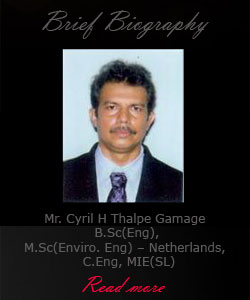WASTE FILL ROADS
Municipal Solid Waste Management has become the biggest unsolved problem shouldered by the Local Governments. However much planned by the municipalities, the strategic activities fail to reach the goals, resulting of a big heap of waste ultimately creating the common problem ‘what to do with it? Public protest against municipalities and politicians tends to shift the waste from place to place with no permanent solution.
Sanitary waste filling technology in the known academic approach is not a sustainable solution because of meager cost effectiveness and useless land utility.
1.Sustainable Municipal Solid Waste Management
Any technical application to solve the problem must be sustainable and let us consider what the requirements for sustainability.
1. Affordability
2. Maintainability
3. Renewability
4. Resilience
The development activity should be easily affordable in the first place. Secondly it should be easily maintainable after implementation. Thirdly the implemented structure or system must be renewable under any future improvement aspects. Finally the system should possess some ability to adjust with or stand against any disturbances to come. Best example for a sustainable development is the ancient ‘Rajarata’ cascade irrigation system which coexisted through thousands of years.
2.What are the Resources in Municipal Solid Wastes?
Solid waste is a resource for municipalities if only the correct practice of ‘Sorting Before Dumping’ could be established. Then only the following processes gain some economic value.
1. Reduce
2. Reuse
3. Recycle
4. Recover
Waste generation can be reduced through awareness raising programs and community can be directed towards waste minimizing municipality strategies.
There are different classes of social status in any society and waste from the upper classes can be a resource for the lower class to reuse. Therefore municipalities should facilitate providing market places and charity shops to sell used goods.
Industrial techno applications induce an economic potentiality for recycling of the sorted waste and some social groups would willingly engage in sorting recyclable items before dumping.
Wherever the aforesaid options are failed, then municipalities have to go for the final option of ‘Recovery’. In this regard composting has a measurable potential but land filling is the ultimate solution remaining.
However, ultimately no suitable dumping areas to find and the local communities seem to protest against the municipality discipline in solid waste management.
3.How to recover the ultimate value of the waste?
There are lots of highly mechanized practices adopted in western countries to sort the waste after dumping but all in vain in consideration of cost effectiveness. Our academic approaches and measures upon solving of the waste problem too seem to be highly dependent upon European technologies which are perhaps abandoned by the founders themselves, due to unbearable capital and maintenance cost.
But as yet those non-sustainable methodologies and their machineries are being sold to developing countries to compensate their capital losses. That ugly business would be succeeded as far as the Global Knowledge Departments are governed in the mighty invisible hand of the Developed countries. All of their unproven crazy practices, even still at experimental stage, are crept in to the syllabus and our scholars of academic thinking adopt them in their project consultations.
However ultimately the loss is to the country and it is suggested hereby to Assess not only Environmental Impacts but also Sustainability aspects of projects before implementation, by a National Advisory Council of specialists or unless such nonproductive and unsustainable projects shall waste a great deal of public money.
Sorting of waste before dumping is the best practice if municipalities can execute through a community participatory approach and that is the most suitable methodology for developing countries where manpower is cheaply available. Then only some values could be achieved through reuse, recycling and recovery regarding Municipal solid waste management.
However in case Municipalities fail to sort their wastes before dumping, then it is of no use blaming each other and only thing remaining to do is Land Filling. It is economical and productive as well, in consideration of the land value with reclamation. But essentially it should be a sanitary waste filling or otherwise the projects could be failed upon Environmental aspects.
4.Sanitary Waste Fill Roads
The innovative technology introduced herein is suitable for municipalities or provincial councils at where the need is there for construction of a road.

FIGURE-01
As shown in the figure-01 and figure-02, the road stretch if excavated and the cut soil is kept aside for backfilling. The precast concrete cylinders are placed upon the base as shown in figure-02, and a thin concrete layer is applied to the bottom of each cylinder.

FIGURE-02
The cylinders are gradually filled by the solid waste and at the same time covered by the cut soil as shown in the figures. The road construction too is followed gradually through the proper sequence of processes so that no work component is disturbed by the other.
The waste is confined within the cylinders so well that any leakage or exposure in to the environment is not possible at all.
5.Advantageous Effects of the new technology
1. The advantage in the first place is the high economic value addition for the waste by using as the filling material in road constructions.
2. The technology doesn’t allow the municipal waste to be exposed and therefore no protest from the public could be expected because no odor comes out.
3. The technology prevents earth cutting and transporting from distant burrow areas and therein saves energy and the most depleting natural resource.
By
Eng. Cyril H Thalpe Gamage
Engineering Consultant
BSc. (Civil)-SL, MSc.(Env- Eng)-Nether Lands, Chartered MIESL



